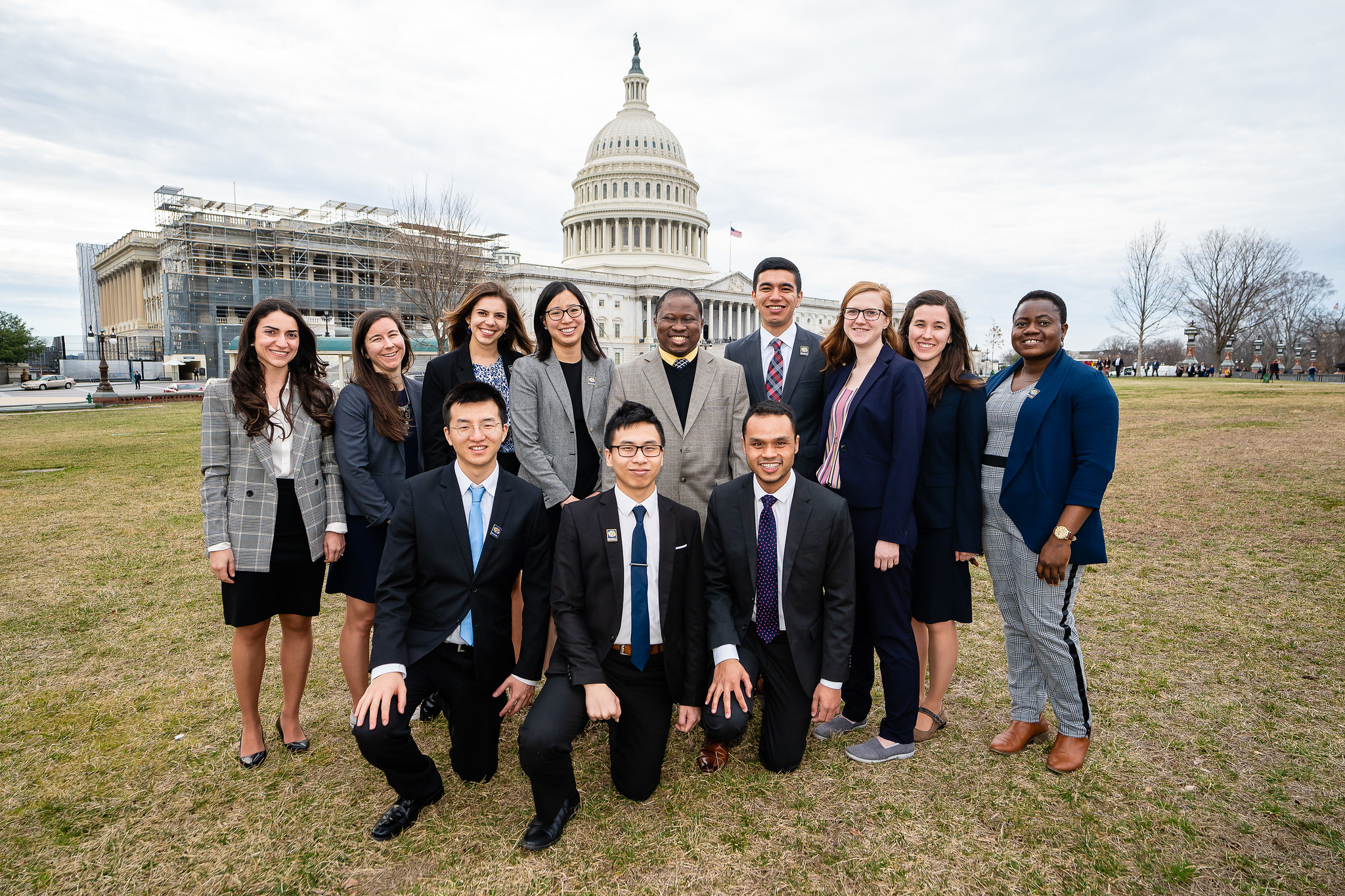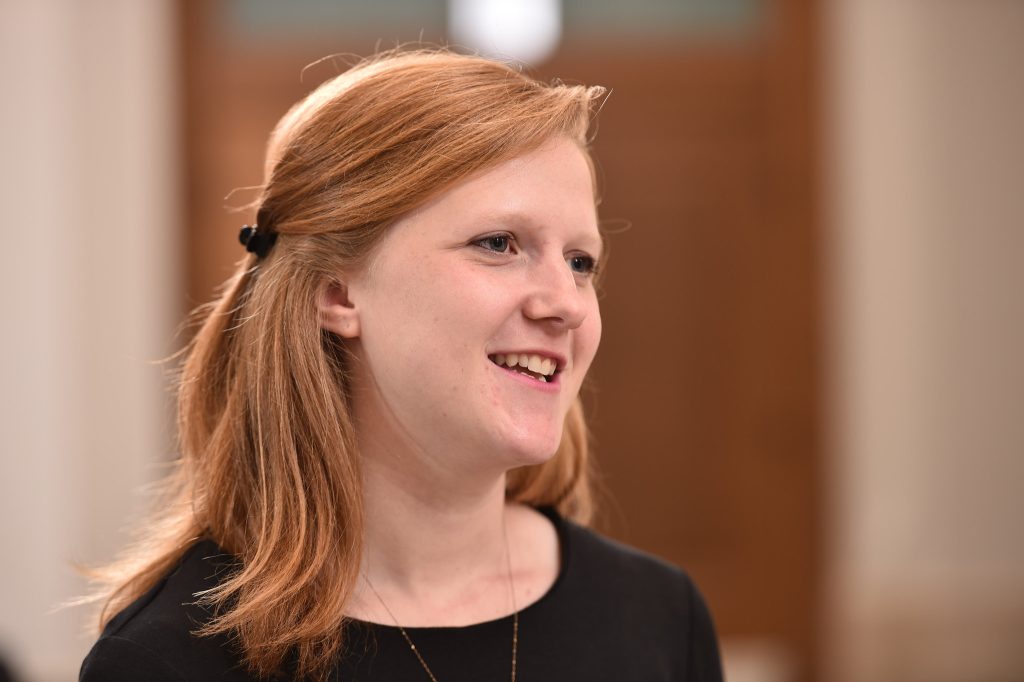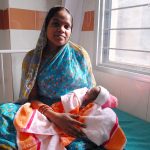When Caroline Andridge arrived at Notre Dame in 2017 as a member of the inaugural master of global affairs class at the Keough School of Global Affairs, she already knew she wanted to learn all she could about food and water security. She selected the program’s sustainable development concentration as her focus, tailored nearly every assignment to her academic interests, and sought out faculty mentors with expertise in food systems.
Seven years later, Andridge (MGA ‘19) works in exactly the kind of job she had hoped for as a student: senior program officer for nutrition at Results for Development, a Washington, DC-based global development nonprofit focused on health, education and nutrition. In this role, she connects and provides technical assistance and data analysis for funders, advocacy organizations and policymakers to facilitate sustainable financing and policy coordination for nutrition programs.
Before joining Results for Development, Andridge worked for USAID as a US policy specialist in the Bureau for Humanitarian Assistance (formerly the Office of Food for Peace) in Washington. She now works remotely from her home state of Michigan.
What is your role at Results for Development?
I try to get our evidence base (research) into the hands of decision makers and those who do advocacy work so that it can be used to inform spending and policy and programming decisions. That can be really helpful, particularly for organizations within a country to use with their own governments to encourage them to increase spending in certain areas.
I support donors by helping them track and standardize their investments to understand what they are used for. For example, we recently worked closely with governments in Nigeria, Ethiopia and Ghana to support nutrition policy, planning and programming. I also work with funders such as the Gates Foundation and the SUN (Scaling Up Nutrition) Donor Network on their nutrition financing and accounting to help them gauge how much they’re spending on nutrition and where their money is going.
Though nutrition is my focus, my work spans multiple sectors. For example, I’m involved in an education project where we’re working with several governments to create a global guide on how to integrate services for children’s development through primary healthcare systems. It’s a program focused primarily on health and education, but I’m a member of the team that brings nutrition expertise.
How do you define nutrition in international development?
You might think it would be a simple question, but it’s actually quite complicated. There is an aspect of nutrition called nutrition-specific, or basic nutrition. That describes things that are really nutrition at the core.
A clear example of this is treating “wasting,” the most visible and dangerous form of malnutrition that leaves children vulnerable to illness, developmental delays, and even death. Unfortunately the rates of wasting have been increasing around the world in recent years. You treat wasting through supplementary feeding products and a few different kinds of nutritional therapy treatments. So that’s a really clear example that everyone agrees is nutrition.
On the other hand, you have things that might be called nutrition-sensitive or indirect nutrition intervention that have an impact on nutrition, but through a more complex causal pathway. One example is WASH (water and sanitation and hygiene), which has clear impacts on the nutrition of a community. Another example of indirect nutrition might be livelihood training for women. We have evidence that if you improve the livelihoods and economic independence of women, the nutrition of their families will often improve.

What are the most pressing global issues related to nutrition?
Malnutrition is on the rise. For quite some time, the trend has been positive with malnutrition and hunger in general—we are feeding more children and reaching more with nourishing services. But over the last several years, we’ve actually seen malnutrition going up again. Progress on stunting (impaired growth from malnutrition) has stalled and wasting is increasing. And even in lower-income countries, we see obesity increasing as well, which is a different form of malnutrition. So a big concern for Results for Development is to ensure there is enough financing to fund those nutrition programs. So that’s an area that I work on a lot and that the organization is known for—this sustainable financing element.
The problem of nutritious food systems is also a pretty big one: ensuring there is enough nutrition in the calories. There is a growing attention on food systems due to what we call the three Cs: COVID, conflict and climate change. All three factors have spurred interest in our complicated, complex food systems that often leave the people who produce the food the hungriest.
What are the most rewarding parts of your job and what are the challenges?
One of the rewards is to see our research used for policymaking. That’s why we do the work of compiling information, providing analyses and assessments of financing and comparing it to the needs. It’s exciting to have people want to see the data and be able to craft compelling advocacy messages so funding can reach the most vulnerable. It’s exciting and rewarding.
One example is when we provided UNICEF specific data analysis on wasting treatment and worked with them on advocacy messaging that contributed to their Child Wasting Alert campaign in 2022. The campaign then helped contribute to an unprecedented pledge from multiple government and private sector donors that provided $577 billion in 2022 to treat wasting. Our analysis was only one piece of a much bigger puzzle, but it was exciting to contribute in that way.
One big challenge is competing priorities. We need to do more financing and programming for nutrition, but that’s only one area of international development. So when you’re asking for more financing for nutrition, it has to come from somewhere, and that might mean less funding for other important things like health or education. We try hard not to frame the narrative as a zero-sum game, but working in a space where there are a lot of different and compelling needs can be challenging.
How did the MGA program prepare you for your current role? What aspects of your education and training do you find yourself using now?
I learned a lot of the skills you need for clear communication. It was emphasized in our assignments especially through the policy memos we wrote for class and also in the data visualization courses. The ability to communicate concisely and clearly about complicated or niche topic areas is so important. I also learned a lot about evidence translation: not only doing the analysis, but then also phrasing it or articulating it in a way that’s accessible and approachable and understandable to an audience who hasn’t been involved in the data analysis. It’s important to present your work in a factual but also compelling way.
The Keough School also gave me the ability to explore different career paths within sustainable development. Meeting a wide variety of professors and practitioners helped me think about the kind of work I wanted to do when I graduated and what the day-to-day work might look like.
So, what was it like to be part of the Keough School’s first master of global affairs class?
It was intense, the first year especially, but it was exciting. We were both pioneers and guinea pigs. We were so enthusiastic about this new school that provided a new space for a conversation about international development. I chose the Keough School because of its focus on human dignity and human development—a focus that included but also went beyond economic development.
When I think of what it was like being part of the Keough School, it was 110 percent about my classmates. My classmates, some of the most amazing people I’ve ever met, were foundational for the enjoyment, learning and appreciation that I gained from the program. The faculty and the staff are wonderful; I learned a ton from the professors. But above all I was grateful to be a part of this really special group of students for two years and learn from them. I’m still in touch with a lot of them now, and when I think of what it means to be part of that first class, they’re the people I’m thinking of and am proud to be associated with.

What advice do you have for current and future MGA students at the Keough School?
First, spend time with your classmates. That’s going to happen naturally, but going out of your way to spend quality time with them, get to know them, and learn from them is essential. On Saturdays my classmates and I would go to somebody’s house and make pancakes together; it was wonderful. Sometimes we talked about things we were learning in class, and other times we discussed other topics. I learned about what life is like in Uzbekistan and Pakistan and Chile and Chicago. That’s where a lot of the learning happened for me.
I also recommend tailoring all of your assignments to the main topic you’re interested in. I wanted to gain a greater understanding of food and water security, so I tried to be intentional about making every assignment related to those topics so I could apply what I was learning through that lens. The professors were very supportive of that and that kind of flexibility has had a tremendous impact on my career.
This interview has been edited and condensed.



